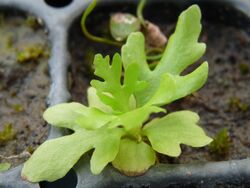Biology:Ceratopteris thalictroides
| Ceratopteris thalictroides | |
|---|---|

| |
| Ceratopteris thalictroides, showing typical above-water foliage | |
| Scientific classification | |
| Kingdom: | Plantae |
| Clade: | Tracheophytes |
| Division: | Polypodiophyta |
| Class: | Polypodiopsida |
| Order: | Polypodiales |
| Family: | Pteridaceae |
| Genus: | Ceratopteris |
| Species: | C. thalictroides
|
| Binomial name | |
| Ceratopteris thalictroides (L.) Brongn.
| |
Ceratopteris thalictroides is a fern species belonging to the genus Ceratopteris, one of only two genera of the subfamily Parkerioideae of the family Pteridaceae.[2]
Common names
Ceratopteris thalictroides is commonly known as water sprite, Indian fern, water fern, oriental waterfern, and water hornfern. In the Philippines, it is called pakung-sungay (literally 'antler fern' or 'horn fern').[3][4]
Distribution
Ceratopteris thalictroides is widespread across tropical regions.[4][5]
Description
Rooted in mud, Ceratopteris thalictroides plants vary in size and appearance. The stipes of mature plants are 3–15 mm in diameter, spongy, and air-filled with 4–60 centimeters (1.6–23.6 in) long including its stipe.
Pale green, brown when matured, fertile fronds are 15–100 centimeters (5.9–39.4 in) or more, including the stipe, to 40 centimeters (16 in) long. Proliferous or dormant buds with their overlapping dark scales present in the axils of fertile pinnae are winged. Pinnae are deeply incised with segments 2–15 mm x 10–30 mm and the fertile segments 1–2 mm x 10–80 mm.[6]
In the north type and the third type, the count of chromosomes is 2n=126 while in the south type its 2n=154, making it separate from species.[7]
Ecology
Ceratopteris thalictroides is often found near stagnant water or in still pockets along slow flowing rivers in swampy areas, swamp forests, sago swamps, marshes, natural and man-made ponds. The plant thrives in full sun to moderate shade, from sea level to 1,300 meters (4,300 ft) in elevation, but mostly less than 500 meters (1,600 ft) in elevation. Ceratopteris t. is often massed on or around logs or other floating vegetation. The plant was once recorded in a fresh-water mangrove (Sonneratia) growing among the finger-like pneumatophores. In some areas, Ceratopteris exhibits a degree of seasonality, reaching maturity and shedding spores during the dry season; plants have lost nearly all sterile fronds by this stage.[6] The species has been reported to functionally be an annual, repopulating from spores the next season, but it is clearly of indefinite lifespan in cultivation.[citation needed]
Uses
Culinary
Fronds are cooked and eaten as a vegetable in Madagascar ,[4] New Guinea[citation needed], and Vietnam,[8] and raw as a salad in Micronesia.[citation needed]. It has been used similarly to watercress.[4] In Malaysia and Japan , uncurled fronds have been used in salads.[4] However, the plant is believed to contain carcinogenic chemicals.[citation needed]
Other
Ceratopteris t. is widely used as an aquarium plant,[4] and is prized for its versatility, being used both as a floating plant and a plant that can be rooted in the substrate.[9]
The plant can be used as manure for rice.[4]
Ceratopteris t. is used medicinally as a poultice for dermatological issues in Malaysia and the Philippines.[4] In China, it's applied to wounds to stop bleeding.[4]
In the Sepik region of New Guinea, fronds are used as a personal decoration.[citation needed]
Cultivation
It grows best in soil with a pH reading of 5-9 and in very high amounts of light. It usually grows quickly.
Ceratopteris t. can benefit (like all aquatic plants) from the addition of CO2. The plant's reproductive technique is similar to other ferns. Small adventitious plantlets are grown on the mother plant and are then released when ready.
It can provide useful shade to shyer fish and small fry. The dense roots are said to take nutrients out of the water, helping to prevent the growth of algae.
See also
- Diplazium esculentum
- List of endemic plants in the Mariana Islands
References
- ↑ Irudayaraj, V.; Lansdown, R.V. (2019). "Ceratopteris thalictroides". IUCN Red List of Threatened Species 2019: e.T168862A84005839. doi:10.2305/IUCN.UK.2019-2.RLTS.T168862A84005839.en. https://www.iucnredlist.org/species/168862/84005839. Retrieved 18 November 2021.
- ↑ PPG I (2016), "A community-derived classification for extant lycophytes and ferns", Journal of Systematics and Evolution 54 (6): 563–603, doi:10.1111/jse.12229
- ↑ Amoroso, Victor (2007). "Pteridophyte and gymnosperm diversity in Musuan, Bukidnon". Philippine Journal of Systematic Biology 1: 1–14. http://asbp.org.ph/wp-content/uploads/2016/08/906-3028-2-PB.pdf. Retrieved 2021-07-01.
- ↑ 4.0 4.1 4.2 4.3 4.4 4.5 4.6 4.7 4.8 Vegetables. G. J. H. Grubben, Plant Resources of Tropical Africa. Wageningen, Netherlands: Backhuys. 2004. pp. 173–175. ISBN 90-5782-147-8. OCLC 57724930. https://www.worldcat.org/oclc/57724930. Retrieved 2021-07-01.
- ↑ Irudayaraj, V; Lansdown, R.V.. "Ceratopteris thalictroides. The IUCN Red List of Threatened Species 2019". IUCN Red List of Threatened Species. https://www.iucnredlist.org/species/168862/84005839#geographic-range. Retrieved 1 June 2021.
- ↑ 6.0 6.1 Ceratopteris thalictroides in Australian National Herbarium
- ↑ Liao, Yi-Ying; Yang, Xing-Yu; Motley, Timothy J.; Chen, Jin-Ming; Wang, Qing-Feng (2011-07-12). "Phylogeographic analysis reveals two cryptic species of the endangered fern Ceratopteris thalictroides (L.) Brongn. (Parkeriaceae) in China". Conservation Genetics 12 (5): 1357–1365. doi:10.1007/s10592-011-0236-7. ISSN 1566-0621. Bibcode: 2011ConG...12.1357L. http://dx.doi.org/10.1007/s10592-011-0236-7. Retrieved 2021-07-01.
- ↑ Tanaka, Yoshitaka; Van Ke, Nguyen (2007). Edible Wild Plants of Vietnam: The Bountiful Garden. Thailand: Orchid Press. p. 108. ISBN 978-9745240896.
- ↑ James, Barry (1997). A fishkeeper's guide to aquarium plants (Rev ed.). Blacksburg, VA: Tetra Press. ISBN 1-56465-173-8. OCLC 39143686. https://www.worldcat.org/oclc/39143686. Retrieved 2021-07-01.
External links
- PROTAbase on Ceratopteris thalictroides
- Flora of North America: Ceratopteris thalictroides
- Nonindigenous Aquatic Plants: Ceratopteris thalictroides at UF/IFAS Center for Aquatic and Invasive Plants
- Australian National Herbarium
- Tropica
- How to Grow and Decorate with Watersprite
Wikidata ☰ Q2946391 entry
 |


